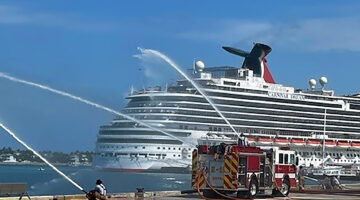The Big Pine Key Brush Fire: The Initial Response and What to Expect
The operation is shifting from the initial attack to mop-up.
FIRE FIGHTING RESPONSE: INITIAL ATTACK
The initial 911 call about a fire on Big Pine Key came in at 1: 52 p.m. on Sunday (April 22). Monroe County Fire Rescue received the alarm call at 1:53 p.m. and arrived at the fire just three minutes later. The fire in a wooded area spread quickly with windy and dry conditions, and with the large supply of “fuel” due to dead, dry vegetation from Hurricane Irma. Soon, nine agencies were involved in the firefighting response on Sunday. A Unified Command of Monroe County Emergency Services, Florida Forest Service and the US Fish and Wildlife Service was established to manage fire suppression operations.
Since this fire is a wildfire, the objective is to put it out (full suppression). There is no agency intent to allow portions to burn more acreage for any reason.
PROTECTING LIFE AND PROPERTY
The first and most important priority of the fire response is protection of life and property and will remain so for the duration of the operations.
As of Thursday, April 26, 72 acres have burned and one private home and separate garage on a single lot were destroyed (on Sunday right after the fire started). There have been no reported public or responder injuries to date and no wildlife injuries or mortality confirmed.
The initial response of professional firefighters (both structural and wildland) is actively attacking the fire at the highest priority locations (personal homes and property) and in strategic locations to thwart the spread of the fire. This is called the “initial attack,” which is currently winding down. Close observation of weather, operational coordination among agencies and asking for the right number and type of additional resources occurred in this initial attack since Sunday.
Fire lines were established on existing roads and trails where it is safe, reasonable and strategic for firefighters to hold fire within a confined area and not let it out. This area is shown on the map below and the fire still remains within confines of that space. Not all the available green vegetation (fire “fuel”) within the area is necessarily burnt. That is because those fuels may not exist in a safe, defensible location so firefighters move out a bit to a more defensible location.
Even though the fire is currently confined to this area, you will hear it is only some percentage “contained.” Today, the fire is 60 percent contained. Firefighters use the term “containment” as a euphemism for describing the progress of stopping the spread of acreage. We have not yet achieved full control of this fire. An example of this is Tuesday, an ember from a smoldering tree snag blew over the fireline with a gust of wind starting a new fire. It was tiny and firefighters patrolling at the location immediately put it out, thus we still need to work to get the fire fully under control.
Cold fronts, wind speed shifts and temperatures affect fire behavior and we had a front pass through early morning yesterday and another is scheduled to pass through Friday evening. Winds shift nearly 360 degrees with frontal passages and smoke is distributed in those new directions – so people who had no smoke on Sunday and Monday might have had a lot of smoke on Tuesday or Wednesday. That will continue until the fire is fully out.
In the mornings, residents may also see heavy smoke laying on the ground. This is a product of the overnight temperature inversion. The smoke will dissipate when the sun rises.
OPERATION SHIFTING FROM INTIAL ATTACK TO MOP-UP
We’re beginning an operational shift from initial attack to “mop-up.” Residents will notice a decrease in the big red local fire engines and the structural firefighters who came from all over Monroe County and beyond (through County Mutual Aid Agreements already in place before the fire). And, residents will notice an increase in the wildland firefighters and their smaller “brush” trucks and equipment. They will work to ensure that the smoldering remains of the brush fire do not reignite and start another fire.
The local firefighters are moving back to their 911 duty and regular emergency response for us all here in the Keys. The wildland firefighters are also from all over Florida and some came as far as Georgia to help us. This happened as a result of the effective fire organization that exists and agencies working together to bring their available resources to Big Pine Key.
MOP-UP PHASE WILL TAKE “WEEKS”
The mop-up phase of this wildfire will take “weeks.” The exact duration will be determined by the conditions and fire behavior, but wildland firefighters will remain at the appropriate numbers with equally appropriate equipment until the fire is contained and the burning/smoking remains are verified to be safe according to agency standards.
FIRE THREAT CONDITIONS REMAIN
It should be noted that this was a good-sized and complex fire by Big Pine Key standards and the response was large and will be expensive. However, we still have at least 93 percent of the pine rocklands on Big Pine Key with all the Hurricane Irma debris still unburned. Residents and firefighters must remain vigilant and “fire safe” as we remain in dry conditions.
FIRE IS BENEFICIAL TO PINE ROCKLAND HABITAT
The pine rockland habitat needs fire to exist and the plants and animals that rely on the habitat have evolved with fire as a part of life. The resulting wildfire will likely benefit habitats in the long run and has certainly reduced fire fuel that has built up and been deposited by Irma.
[livemarket market_name="KONK Life LiveMarket" limit=3 category=“” show_signup=0 show_more=0]



No Comment